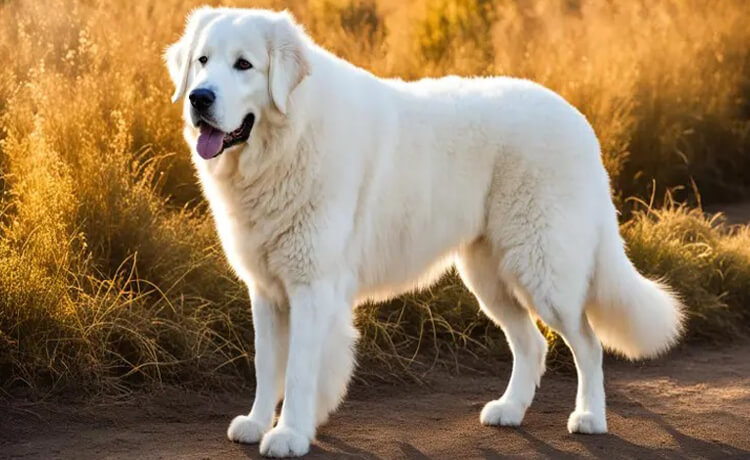
Kuvasz
The Kuvaszis a striking and majestic dog breed, hailing from Hungary where it was historically used as a livestock guardian. Known for its loyalty, protective nature, and imposing presence, the Kuvasz is a perfect fit for families seeking a devoted protector. Let’s dive deeper into what makes this breed so special and whether it might be the right fit for your home.
Key Features
- Size and Build: The Kuvaszis a large breed, with males standing between 28-30 inches tall and females 26-28 inches. They are well-muscled, with a sturdy frame designed to guard and protect livestock.
- Coat: One of the most distinguishing features of the Kuvaszis its beautiful, thick, white coat. The coat is dense and water-resistant, providing protection against the harsh Hungarian climate. Regular grooming is essential to prevent mats and tangles.
- Temperament: The Kuvaszis known for its calm, protectivenature. While they are affectionate and loyal to their family, they can be wary of strangers and fiercely protective of their territory.
History and Origin
The Kuvaszhas a long and storied history dating back to the 15th century. Originating in Hungary, the breed was originally developed to guard livestock, particularly sheep. They were prized by Hungarian nobility for their ability to protect animals from predators like wolves and bears. The Kuvaszwas often seen as a noble guardian, and its role in protecting valuable herds made it an essential working dog on farms.
Throughout history, the breed has remained relatively unchanged, with its protective instincts and strong work ethic remaining at the forefront. The Kuvaszwas later recognized by major kennel clubs, solidifying its place as a loyal companion and guardian dog.
Training and Socialization
- Training: The Kuvaszis intelligent but can be independent and sometimes aloof, which may make training a challenge for first-time owners. Early socialization and consistent, positive reinforcement training are important to bring out the best in this breed.
- Protective Instincts: Being a livestock guardian, the Kuvaszis naturally protective. They are often wary of strangers and will take their guarding responsibilities seriously, making them excellent watchdogs. However, it’s important to train them to differentiate between real threats and harmless situations.
Exercise and Activity Needs
The Kuvaszis an active breed that requires regular exercise to maintain its physical and mental health.
- Daily Exercise: This breed thrives with moderate to intense exercise, including daily walks, jogs, and playtime in a secure yard. The Kuvaszenjoys physical activities like running and hiking, so active owners will find this dog to be a great companion for outdoor adventures.
- Mental Stimulation: In addition to physical exercise, the Kuvaszbenefits from mental challenges. Training sessions, puzzle toys, and interactive play help engage their minds and prevent boredom.
Grooming and Coat Care
- Coat Maintenance: The Kuvaszhas a thick, double-layered coat that requires regular grooming. To prevent mats, it’s recommended to brush the coat a few times a week, especially during shedding season. Bathing should be done as needed to maintain the coat’s cleanliness and texture.
- Shedding: The Kuvaszsheds seasonally, so be prepared for some extra hair during the shedding periods. Regular brushing will help manage the shedding and keep your home clean.
Health Considerations
- Lifespan: The average lifespan of a Kuvaszis between 10 and 12 years.
- Common Health Issues: Like many large breeds, the Kuvaszcan be prone to hip dysplasiaand other joint issues. It’s important to maintain a healthy weight and ensure regular check-ups with the vet.
- Eye Health: Some Kuvaszdogs can develop eye problems, including progressive retinal atrophy, so regular eye checks are recommended.
Fun Facts
- Royal Heritage: The Kuvaszwas favored by Hungarian royalty and nobility for its guarding abilities. It was often seen by the Hungarian aristocracy as a symbol of strength and loyalty.
- Natural Guardians: The Kuvaszhas an incredible instinct for guarding livestock, and its natural protective behavior has made it a sought-after breed for working farms, especially in rural areas.
- Mature Guardians: Unlike many dogs, the Kuvasztends to mature later, with their guarding instincts becoming fully developed by around 2-3 years of age.
- Low Shedding: Despite its thick coat, the Kuvaszdoes not shed excessively, which can be a surprise for potential owners. However, its seasonal shedding requires consistent grooming to maintain its coat.
Is the Kuvasz Right for You?
The Kuvaszis an excellent choice for families who need a loyal and protective dog. This breed does well with families who can provide ample exercise and consistent training. While they can be independent and need socialization, they are loving and devoted to their families once they feel comfortable.
Essentials for Your Newly Adopted Pet
Welcoming a shelter pet into your life is a beautiful journey. Here are some handpicked items to help your new friend feel safe, loved, and right at home:
- Best Fit: The Kuvasz thrives in homes with spacious yards and active owners who can engage them in physical and mental stimulation. Families with children will find this breed a devoted protector, though it’s important to teach children how to interact respectfully with the dog.
Conclusion
The Kuvaszis a remarkable breed with a long history as a livestock guardian. Known for its loyalty, protective instincts, and majestic appearance, the Kuvaszmakes an excellent family dog for those with experience in handling large, independent breeds. With proper training, socialization, and grooming, this breed can be a loving and dedicated companion for years to come.
Affiliate Products
Up to 75% Discount

Dog Collar with Health Monitoring
BUY NOW »
Up to 55% Discount

Luxury Faux Furhuge Napping Bed
BUY NOW »

